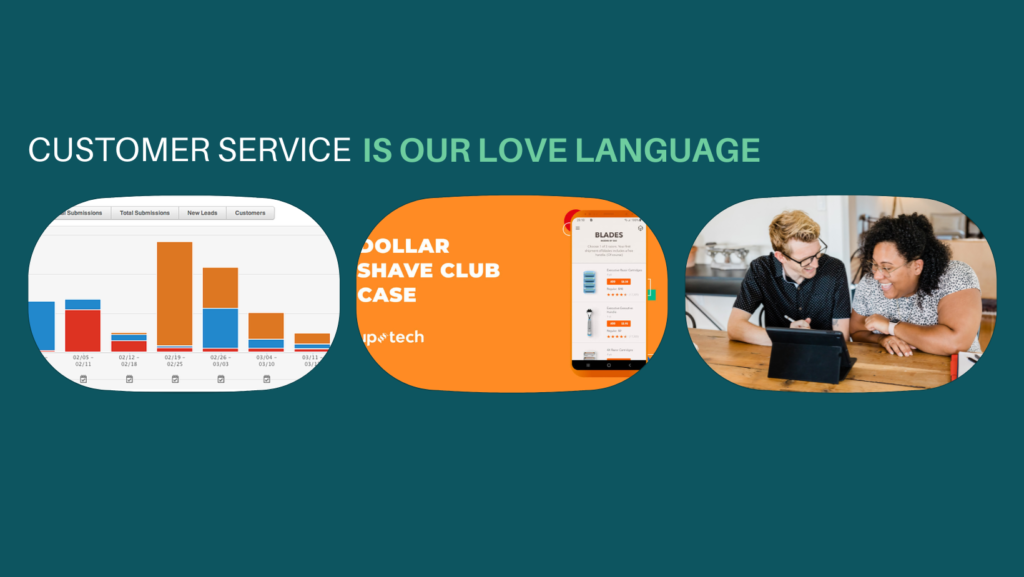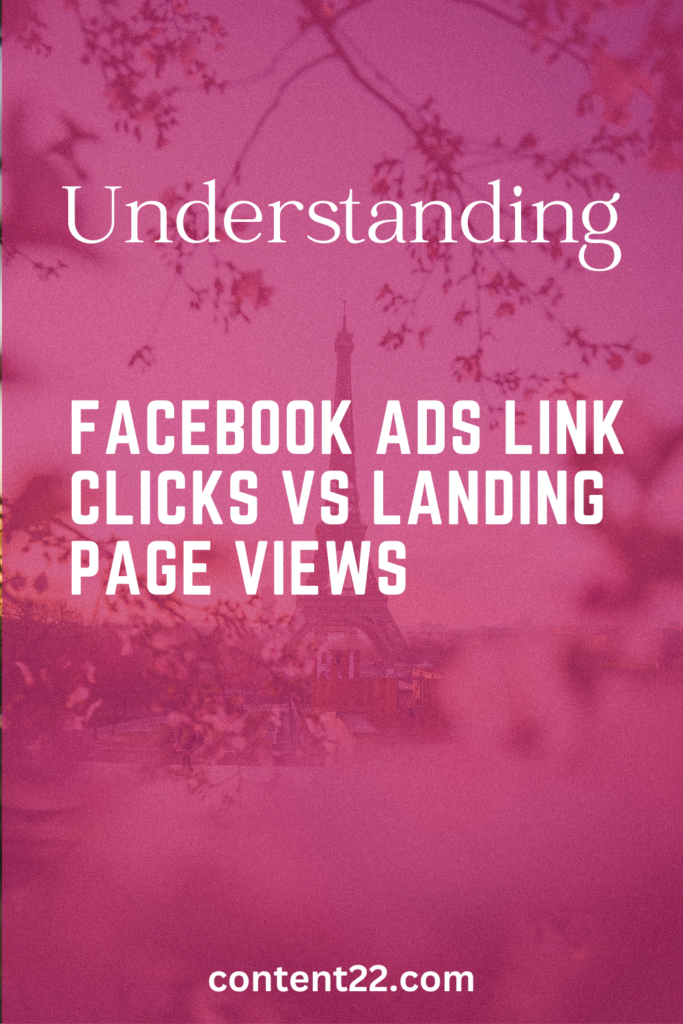
As a digital marketer, understanding the difference between Facebook ads link clicks vs landing page views is crucial to optimizing your Facebook ads campaign. Link clicks refer to the number of times someone clicks on your ad’s link while landing page views indicate the number of times your landing page fully loads after a click.
Both metrics are important, but they serve different purposes.
Link clicks are the number of times people clicked on your ad’s link or call-to-action button.
This metric is essential in determining the effectiveness of your ad’s messaging, targeting, and creativity. Link clicks can also help you understand how well your ads are driving traffic to your website or landing page. However, not all link clicks result in a fully loaded landing page, which is where landing page views come in.
Landing page views, on the other hand, indicate the number of times your landing page loads after a click. This metric is critical in determining the effectiveness of your landing page in converting visitors into customers. A high number of link clicks with a low number of landing page views suggests that your landing page is not engaging enough, resulting in visitors bouncing off the page without converting.
You know that understanding the analytics also gives you information about the number of people who are visiting your site.
And in today’s post, I’ll show you exactly How
Let’s dive right in
Differences between Link Clicks and Landing Page Views
You should be aware that the difference between Facebook ads link clicks vs landing page views may seem subtle, but it can significantly impact the performance of your Facebook ad campaign. Link clicks are a measure of engagement while landing page views are a measure of conversion.
For example, suppose your ad has a high number of link clicks but a low number of landing page views. In that case, it indicates that people are clicking on your ad but not staying long enough on your landing page to convert. This may be due to a lack of relevance between your ad and the landing page or a poorly designed landing page. On the other hand, a high number of landing page views with a low number of link clicks suggests that your ad’s messaging or creativity is not compelling enough to drive clicks to your landing page.
It’s important to note that not all link clicks result in landing page views. If someone clicks on your ad’s link but quickly bounces off the landing page, it won’t count as a landing page view. Similarly, if someone clicks on your ad link multiple times, it will count as multiple link clicks but only one landing page view.
I know that Facebook ads link clicks vs landing page views in your analytics will be very beneficial to how your ad set is performing.
When to use Link Clicks vs Landing Page Views
Facebook ads link clicks vs landing page views Knowing how they affect your ad campaign’s traffic objective.
Conversion events are an important part of digital marketing, as they provide valuable insights into how customers interact with a brand or product.
If your goal is to drive website traffic, unique clicks are more relevant. However, if your goal is to convert visitors into customers, landing page views are more critical.
Monitoring outbound clicks on your website can help you better understand user behavior and preferences.
Suppose you’re running a lead generation campaign, where the objective is to collect contact information from potential customers. In that case, landing page views are more important than link clicks because they indicate how many people are interacting with your landing page and potentially filling out the form.
On the other hand, if your objective is to promote a blog post or video, link clicks are more relevant since they indicate how many people are clicking through to your content.
Knowing the difference between Facebook ads link clicks vs landing page views will help you become more precise in your tracking.
Social media creates kinship between companies and customers, and kinship equals purchase intent.
How to measure and analyze Facebook ads link clicks vs landing page views
Measuring Facebook ads link clicks vs landing page views is easy in Facebook Ads Manager. Since the Facebook algorithm is constantly being updated to provide a better user experience and relevance of content. You can view both metrics in the “Performance” tab of your ad campaign. To analyze these metrics, you’ll need to compare them to other metrics such as click-through rate (CTR), conversion rate, and cost per click (CPC).
CTR is the ratio of link clicks to impressions and indicates how well your ad is resonating with your target audience. A high CTR suggests that your ad’s messaging and creativity are compelling enough to drive clicks.
Conversion rate, on the other hand, is the ratio of conversions to link clicks or landing page views and indicates how well your landing page is converting visitors into customers. A high conversion rate suggests that your landing page is engaging and persuasive.
CPC is the amount you pay per link click or landing page view and indicates how cost-effective your ad campaign is. A low CPC suggests that your ad’s targeting and relevance are effective in driving clicks and conversions.
I hope by now you have gained some understanding about Facebook ads link clicks vs landing page views.
Now let’s dive a little further
Optimizing Facebook ads link clicks vs landing page views
Optimizing your Facebook campaign for link clicks and landing page views requires a combination of targeting, messaging, and creativity. Here are some tips to help you optimize your ads:

Use relevant ad targeting
Ensure that your ad targeting is relevant to your audience’s interests, behaviors, and demographics. This will increase the likelihood of them clicking on your ad’s link and visiting your landing page.
- Write compelling ad copy – Your ad’s copy should be clear, concise, and persuasive. It should communicate the benefits of your product or service and encourage people to click on your ad’s link.
- Design eye-catching ad creative – Your ad’s creative should be visually appealing and relevant to your product or service. It should also be consistent with your ad’s messaging to avoid confusion.
- Create a high-converting landing page – Your landing page should be engaging, persuasive, and easy to navigate. It should communicate the value of your product or service and encourage visitors to take action.
Common mistakes to avoid when using Link Clicks and Landing Page Views
• Not setting up the tracking URL correctly: It is important to ensure that all tracking URLs are configured correctly when tracking clicks and page views.
• Not giving enough attention to the landing page: The landing page should be designed and optimized for maximum conversions.
• Not testing the tracking code: It is important to test the tracking code to make sure it is working properly.
• Not tracking the right click and page view data: It is important to track the right data in order to get the most accurate results.
• Not measuring the user experience: It is important to measure the user experience to ensure the page loads are optimized for user engagement.
• Not using A/B testing: A/B testing can help optimize the landing page to increase conversion events.
• Not understanding the customer journey: It is important to understand the customer journey in order to track the right data and optimize the landing page.
• Not optimizing for mobile: Mobile optimization is essential in order to ensure the page is easy to use and navigate on mobile devices.

Case studies of successful Facebook Ads campaigns using Link Clicks and Landing Page Views
Many successful Facebook Ads campaigns have used link clicks and landing page views to optimize their ad performance. Here are a few case studies:
- HubSpot – HubSpot used a combination of link clicks and landing page views to promote their free marketing courses. By optimizing their ad targeting, messaging, and creativity, they saw a 66% increase in landing page views and a 50% decrease in cost per lead.
- Dollar Shave Club – Dollar Shave Club used landing page views to optimize their ad campaign for customer acquisition. By creating a landing page that was relevant, engaging, and persuasive, they saw a 172% increase in conversion rate and a 54% decrease in cost per acquisition.
- Airbnb – Airbnb used link clicks to promote their “Trips” feature, which allows users to book local experiences. By optimizing their ad targeting and creativity, they saw a 2.6x increase in link clicks and a 3.7x increase in bookings.
Tools and resources for tracking and improving Link Clicks and Landing Page Views
A business traffic campaign should focus on increasing brand recognition by utilizing targeted digital and social media outreach.
Facebook Ads Manager is the primary tool for tracking and analyzing link clicks and landing page views. However, there are several other tools and resources you can use to improve your ad campaign’s performance:
- Google Analytics – Google Analytics can provide different metrics and insights into your landing page’s performance, such as bounce rate, time on page, the total number of clicks, and exit rate.
- Unbounce – Unbounce is a landing page builder that allows you to create high-converting landing pages without coding knowledge.
- Facebook Ads Library – The Facebook Ads Library allows you to view and analyze your competitors’ ad campaigns, including their ad creative, targeting, and messaging.
Why do people use Facebook?
Creating a Facebook page for your business is a great way to reach potential customers and build brand awareness.
You know as a Facebook user .you have the ability to create and join communities, share your thoughts and opinions, and interact with people from all around the world. They can also access important news and updates, and find helpful resources to support their interests and passions.
Conclusion and key takeaways
The good news is that understanding the difference between link clicks and landing page views is crucial to optimizing your Facebook ads campaign for success. Link clicks are a measure of engagement while landing page views are a measure of conversion. By tracking both key metrics, you can gain insights into how well your ads are driving traffic to your landing page and engaging your target audience.
To optimize your Facebook ads for link clicks and landing page views, you’ll need to focus on targeting, messaging, and creativity. Use relevant ad targeting, write compelling ad copy, design eye-catching ad creative, and create a high-converting landing page.
Avoid common mistakes such as focusing solely on link clicks, using irrelevant ad targeting, having a poorly designed landing page, and ignoring ad relevance. By following these tips and using the right tools and resources, you can improve your ad performance and achieve your campaign objectives.